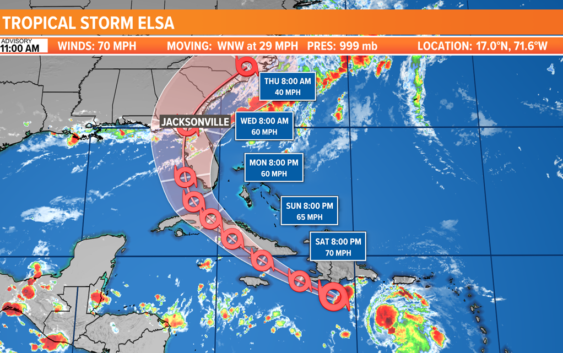- Seven months after Hurricane Helene, Chimney Rock rebuilds with resilience
- Wildfire in New Jersey Pine Barrens expected to grow before it’s contained, officials say
- Storm damage forces recovery efforts in Lancaster, Chester counties
- Evacuation orders lifted as fast-moving New Jersey wildfire burns
- Heartbreak for NC resident as wildfire reduces lifetime home to ashes
Tropical Storm Elsa: Latest projected path, models, and potential impact to First Coast

The main impact for our area looks to be Tuesday and Wednesday. Continue to stay tuned for updates throughout the weekend.
JACKSONVILLE, Fla. — As of 11 AM SATURDAY: Elsa has weakened and is now a tropical storm. The storm is still moving rapidly across the Caribbean at about 29 MPH towards the west/northwest. This system is expected to pass over Haiti and the Dominican Republic later today. Once this storm moves over land, it will lose a significant amount of energy and is forecast to weaken. Impacts to the southern portion of Florida could be seen as early as Monday morning. For the First Coast, current models show impacts as early as Tuesday.
FIRST COAST BIG THREE:
- We will continue to refine the extent of our local impacts, but they will happen after the holiday weekend – likely by late Tuesday and into Wednesday.
- Wet June + Elevated Northeast Florida Rivers + Heavy Rain Potential next 2 days + Potential Elsa Impact = Flood threat
- Gusts up to 60 mph in severe storms are forecast
Tropical Storm Elsa strengthened into a hurricane on Friday morning becoming the first hurricane of the 2021 Atlantic season. The 1991-2020 average date for the first Atlantic hurricane formation is August 14. Impacts to the Florida Keys and Peninsula are still unclear. There remains a great deal of uncertainty on the intensity and track forecast in the long-range as this system moves through the Caribbean and interacts with the Greater Antilles this weekend. If this storm were to impact the First Coast, it looks to be Tuesday at the earlier, but more likely by Wednesday of next week. We will continue to fine-tune that forecast as Elsa’s story unfolds. Make sure to check in at least once a day for updates.
Elsa is also the earliest-known fifth named storm on record for the Atlantic basin in the satellite era (1966-present), breaking the record formerly held by Edouard on July 6, 2020.
It should be noted that the average NHC track errors are 175 miles and 200 miles at days 4 and 5, respectively. Given the larger-than-normal uncertainty and because hazards will extend well away from the center of the storm, everyone is urged to not focus on the exact forecast points.
NHC KEY MESSAGES:
1.Tropical storm conditions are expected and hurricane conditions are possible over southern portions of Hispaniola on Saturday.
2. Heavy rainfall will impact the Cayman Islands and Cuba Sunday into Monday morning, resulting in significant flooding with mudslides in Cuba. As Elsa approaches the Florida Keys and southern Florida early next week, isolated flash flooding and minor river flooding will be possible.
3. There is a risk of wind and rainfall impacts in portions of Cuba, the Turks and Caicos, and the Bahamas through early next week. Interests in these areas should monitor Elsa’s progress and updates to the forecast.
4. There is a risk of storm surge, wind, and rainfall impacts in the Florida Keys and portions of the Florida Peninsula early next week. However, the forecast uncertainty remains larger than usual due to Elsa’s potential interaction with the Greater Antilles this weekend. Interests in Florida should monitor Elsa’s progress and updates to the forecast.
Hurricane season is already here and it’s time to be prepared if you aren’t already. Make sure you have had conversations with your loved ones about what you would do if a storm were to threaten.
This year, NOAA released the new seasonal averages for the Atlantic basin. According to the 30-year data from 1991 to 2020, the new averages include 14 named storms, 7 hurricanes, and 3 major hurricanes. The previous Atlantic storm averages, based on the period from 1981 to 2010, were 12 named storms, 6 hurricanes, and 3 major hurricanes. The averages from 1951-1980 , were 11 named storms, 5 hurricanes, and 1 major.
Hurricane safety and preparedness are critically important before the season begins on June 1. NOAA’s National Weather Service provides resources to prepare for hurricane hazards and real-time updates about active weather systems from the National Hurricane Center at www.hurricanes.gov.
The Atlantic hurricane season officially runs from June 1 to November 30.
Download the First Coast News app and sign up for severe weather alerts